The Triassic period of the Mesozoic era (251.9 to 201.3 million years ago) were a time during which dinosaurs emerged and began to evolve into diverse varieties, building the foundations for their future dominance. Mammals, as the ancestors of humanity, also are said to have first appeared during this time. And today, the world of academia is heating up over this period during which life on Earth changed so significantly. Though evidence is still lacking, one research group at Kyoto University believes that "This great change of life was caused by massive rains, which were in turn triggered by immense volcanic activity," and they have found some highly promising clues to back up their theory. It has become a wide-reaching topic of research which may even lead to the explanation of the mass extinctions which have occurred repeatedly throughout Earth's history.
The mysterious rains of the supercontinent Pangea
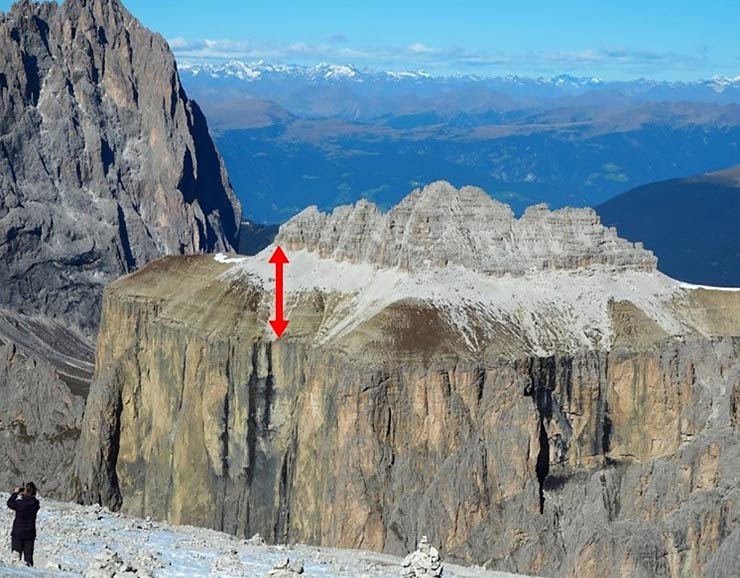
The supercontinent Pangea, and the Panthalassan Ocean that surrounded it, were formed during the late Paleozoic era. Until it broke up towards the end of the Triassic period, Pangea remained generally hot and dry. However, it is clear that during a period of about 2 million years during the Triassic period, lasting from 234 to 232 million years ago, there was a period of exceptionally heavy rains. This is proven by the fact that the sediment washed from the land into the sea during that time can be found in strata throughout the world today. These were identified by researchers from the UK in 1989, and the name "Carnian Pluvial Event" was assigned due to the fact that it occured during the Carnian stage within the Triassic period, or 237 million to 227 million years ago.
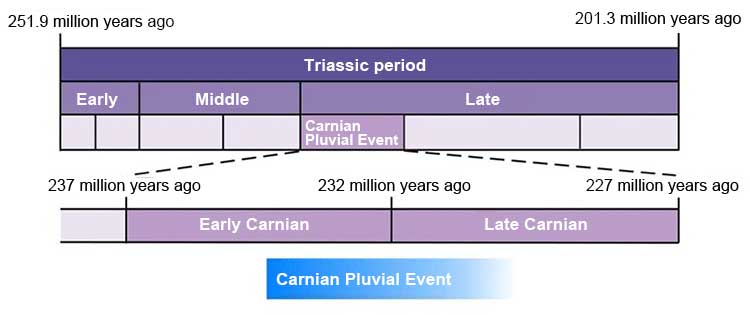
These rains altered the vegetation found on land, while the nutrients washed into the sea from eroded rocks led to an explosion of plankton in the ocean. This in turn caused a drastic change in the environment when the plankton consumed all the ocean's oxygen. This is believed to have caused a major change in life on Earth, including an explosive diversification in types of dinosaurs, as well the emergence of mammals. However, it is unclear what caused these rains. One Canadian researcher made the claim ten years ago that the rains were caused by volcanic activity, but detractors pointed out the uncertainty of the dating of the basalt rock found in the Pacific Northwest in North America which he gave as evidence. It therefore remained unclear whether the rains and volcanic activity had occurred simultaneously, leading the research into a dead end.
"These rains were a transitional period for life on Earth that led to the emergence of humanity, and were therefore an extremely important event in Earth's history. It is very important that we unravel this mystery." Professor Tetsuji Onoue (Geologist) of the Kyushu University Graduate School of Sciences explains his motivation for the research.
A clue in strata found in Gifu prefecture
Onoue's research group examined chert, a type of sedimentary rock, found along the Kiso riverbank in Sakahogi, Gifu prefecture. Chert is formed when dead plankton accumulates on the bottom of the ocean. The chert found in the Kiso river is in good condition and is a rich source of fossils, and is therefore well known throughout the world as a place to examine a long period of Earth's history, including the Carnian stage.
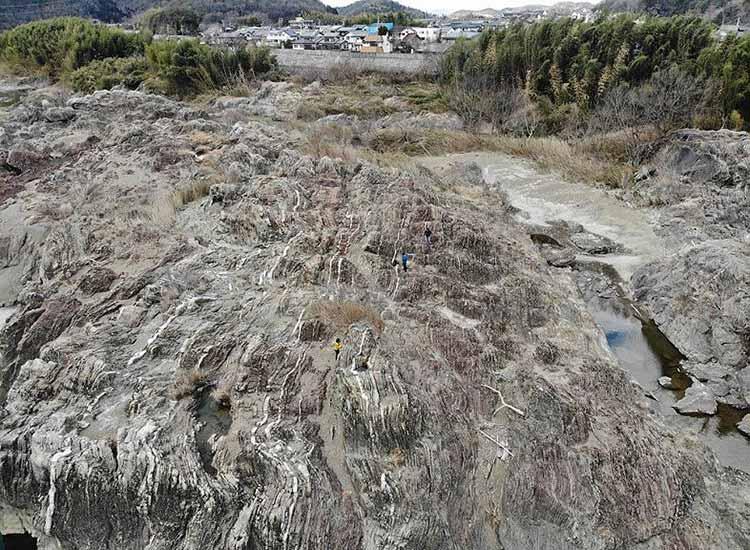
When the group examined the element osmium found within the chert from the early Carnian stage, they discovered a unique isotopic ratio. Isotropic ratios tell a tale of the process by which material came to be where it is, and are an indicator used widely in research. For this osmium, a characteristic isotopic ratio was found over a long period of time. Accordingly, the group determined that the osmium was forced up to the sea surface from the mantle, part of the deep structure inside the Earth, during volcanic activity which coincided with what is called a "superplume," when part of the mantle rises to the Earth's surface. This made it clear that there had been volcanic activity taking place during the early Carnian stage.
The group then went on to confirm clues that the timing of the volcanic activity and the heavy rains perfectly coincided, including characteristics found in fossils of the vertebrate Conodont from the period, and based on the carbon isotope ratio of organic matter found in sediment in various locations. Onoue's research group concluded that, "It is very likely that the Carnian Pluvial Event was triggered by volcanic activity."
The scenario Onoue suggests is the following. "A superplume caused massive volcanic activity to occur in the Panthalassan Ocean, which warmed up the Earth. This allowed a greater amount of water vapor to be contained in the atmosphere, causing heavy rains to fall."
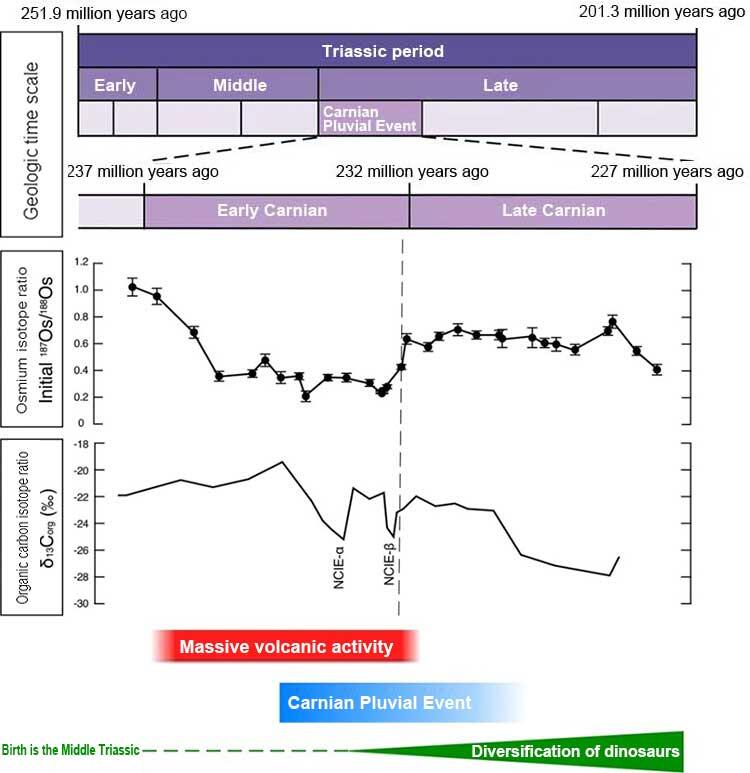
The next difficult challenge is finding causality
Onoue explains, "Numerous forms of life emerged during the Triassic period that continued to modern times, including mammals. Traces of the volcanic activity which triggered the emergence can be found in the form of basalt rock right next to the chert on the Kiso riverbank. I was very surprised to discover that this was recorded in strata here in Japan."
Other participants in this research include Kumamoto University and the Japan Agency for Marine-Earth Science and Technology (JAMSTEC), as well as cooperation from researchers in Italy. The results were published in the digital version of Global and Planetary Change, an international journal on the Earth sciences, on November 25, and announced by Kyushu University last month.
The discovery that the volcanic activity and heavy rains occurred simultaneously surely represent a major leap forward in unraveling the history of life on Earth. However, with regard to the causality between the two occurrences described in the scenario above, there is still no clear proof, though it is "the most likely story." To put it bluntly, they may simply have occurred at the same time coincidentally. Therefore, the next hurdle to overcome is to find a method to clarify the relationship between them.
One more mass extinction that shocked the world
The research group came up with an important theory regarding the massive volcanic activity.
Regions with basalt formed during the massive volcanic activity can be found not only in the northwest of North America and in Japan, but in many other locations around the Pacific Rim, including the Russian Far East. This fact stuck in Onoue's mind as strange for many years, but he realized something when he learned that each location formed during the early Carnian stage. "I realized that each of these locations formed during the same period of volcanic activity."
A superplume occurred in the middle of the Panthalassan Ocean during this time, forming a single massive basalt formation. Later, oceanic plates began shifting at the same time as supercontinent Pangea started to break up, causing the break up of the basalt formation, spreading it to the regions where it is found today. Therefore, it is likely that this volcanic activity caused the Carnian Pluvial Event.
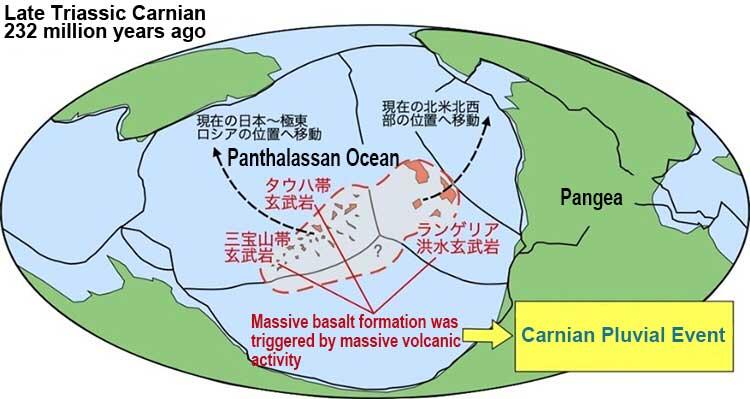
The Carnian Pluvian Event has recently become an object of increased interest. The reason is that an overseas research group published a paper in September of last year that shocked the world with its assertion that a previously unknown mass extinction event occurred during the period that eventually led to the dominance of the dinosaurs. The paper was published in the US science journal, Science Advances. If this were true, then it would have occurred between the third and fourth of the five known mass extinctions, and according to Onoue's findings, it is highly likely that the trigger of the event was the volcanic activity.
"It seems that rocks had a strong grip on the fate of life."

Of the mass extinctions, the extinction of the dinosaurs due to an impact event during the Cretaceous period is well known. Meanwhile, it is considered certainty that the third known mass extinction, which occurred at the border between the Permian period of the Paleozoic era and the Triassic period of the Mesozoic era (about 251.9 million years ago), was caused by volcanic activity. It has also been pointed out that volcanic activity was at least present during the other mass extinctions.
It was also learned during this research that the oceans were depleted of oxygen during the peak of the period of volcanic activity. Unquestionably, the relationship between the volcanic activity and the mass extinction will become a major topic of research for the fields of Geology and Paleontology
Onoue explains, "The motivation for this research is to learn the history of evolution which led to humanity. The questions of what dangers life overcame, or when life became extinct, are deeply fascinating. I feel that chemical and physical changes in rocks hold the key to the fate of life. I'm not sure yet what purpose the research will serve, but I believe it may serve as a guide for considering the future of life on Earth."
In what way did humans come to prosper, while other life forms became extinct? This mystery we have long pursued has come to a very interesting turning point, and we may be on the eve of a complete rewrite of Earth science textbooks.
Original article was provided by the Science Portal and has been translated by Science Japan.




